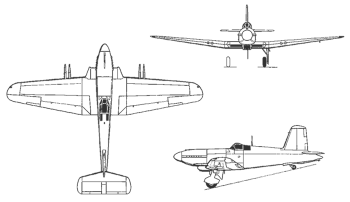



Although it entered service during the middle of World War II (where it did not see action), the Blackburn Firebrand only began appearing in large numbers during the post-war era. It was designed as a carrier-based fighter by G. E. Petty but featured the unsual ability to carry a torpedo (much like its contemporary, the Wyvern) as well as an airspeed gauge mounted outside the cockpit so that the pilot would not need to look down during landings. It was eventually decided that the Firebrand would perform successfully as a strike aircraft armed with bombs and rockets but powerplant and stability problems plus the conversion to this new role delayed development until these deficiencies were solved thanks to new engines and dive breaks. In this configuration it was finally adopted by the FAA which operated it in front line service from carriers until 1953.
The prototype B.37 first flew on 27 February 1942 and entered production as the Firebrand F.I with the same Sabre engine as the Typhoon. It was converted into a strike fighter as the TF.II with torpedo-carrying capability and later the TF.III with Centaurus engines. Nevertheless, it was unsuitable for carrier operations due to torque and insufficient rudder control. Thus, the improved TF.IV was born featuring new engines, larger tail surfaces, and dive brakes. It was the first variant to be built in significant numbers and was further upgraded as the TF.5 which also included a number of TF.IV conversions.
Preceded by:
NoneSucceeded by:
None | |
| Design | Firebrand TF.5 |
| Type | Fighter/Attack |
| Year | 1945 |
| Crew | 1 |
| Dimensions | |
| Length | 11.81 m |
| Height | 4.039 m |
| Wing Span | 15.62 m |
| Wing Area | n/a |
| Weight | |
| Empty | 5,368 kg |
| Maximum | 7,938 kg |
| Wing Loading | 223.1 kg/m² |
| Performance | |
| Speed | 547 km/h |
| Ceiling | 8,687 m |
| Range | 1,191 km |
| Powerplant | |
| Engine | 1 x Centaurus IX Bristol 1,864 kW |
| Thrust/Weight | 0.42 |
| Armament | |
| Guns | 4 x 20-mmHispano Mk. II |
| Payload | 907 kg |
| Hardpoints | 2 |
| Production | |
| Built | 68 |
| Total | 193 |